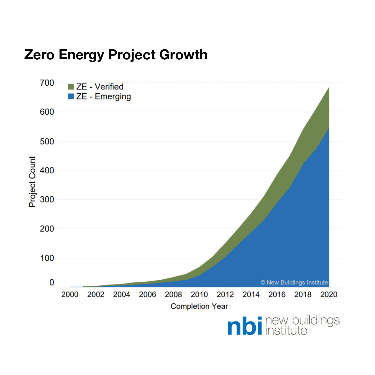

The demand for zero energy buildings across the U.S. and Canada is growing exponentially, according to new data from New Buildings Institute (NBI), a nonprofit organization pushing for better performance in buildings. NBI unveiled its 2020 Getting to Zero Buildings List, which shows the total number of verified and emerging zero energy buildings in North America has grown to nearly 700 – representing a 42% increase since 2018. The total square footage of zero energy buildings has surpassed 62 million, a 39% jump from 2018. The number of verified zero energy buildings in the U.S. and Canada more than doubled between 2018 and 2020, a sign that designers are gaining expertise for delivering on zero energy targets set by building owners.
A “verified” zero energy building is defined as an ultra-low-energy building that consumes only as much energy as it produces with clean renewable energy. These projects must provide 12 months of measured energy use and renewable energy production data. An “emerging” zero energy building is one that has a goal of achieving zero energy, but has yet to be completed or attain zero energy-level performance.
“In the United States, where buildings are responsible for nearly 30% of the nation’s carbon emissions, zero energy buildings will continue to play an important role as we transition to a low-carbon economy,” says Ralph DiNola, CEO of NBI. “Because so many of the zero-energy buildings we are tracking run entirely on electricity and include on-site renewable energy generation, they are proving to be a cost-effective way to reduce carbon emissions, achieve deep energy savings, and improve the indoor air quality of homes and commercial buildings.”
2020 Getting to Zero Buildings List Key Findings & Trends
States with climate action goals lead the market. Projects span all climate zones and nearly every state and province. While they are concentrated in California and the Northeastern U.S., zero energy buildings outside these dominant regions grew by more than 20% over the last two years. The states with the most growth in zero energy projects over the last two years are California, Oregon, New York and Massachusetts – not surprising given the ambitious climate action goals set by state and local governments in these places.
Both public and private sectors see strong growth. Publicly and privately-owned buildings continue to grow at a similar pace. Despite owning less real estate than private building owners, publicly owned government offices, libraries, schools, and universities make up a significant portion of NBI’s 2020 Getting to Zero Buildings List. In the private sector, several large companies, including IKEA, Walmart, Google, Apple and Amazon, have completed zero-energy projects. Many of these corporations have already set or have committed to setting science-based emissions reduction targets.
Meeting zero energy goals is more attainable than ever. Twenty percent of the buildings on NBI’s Getting to Zero Buildings List are “verified” – the largest percentage to date – signaling designers are getting better at meeting zero energy project goals. Verified buildings have a median energy use intensity (EUI) of 20 kBtu per square foot per year and consume about half the energy of comparable buildings. The remaining energy demand is met with renewable resources.
NBI’s Getting to Zero Buildings List is North America’s most comprehensive record of zero energy and ultra-low-energy buildings. Find the 2020 list at: www.newbuildings.org/resource/2020-getting-to-zero-project-list/
Anyone can submit projects to the Getting to Zero Database by reporting their EUI and renewable production intensity (RPI) numbers. Once approved to the database, users can easily find project details – such as location, building size and building type – thanks to an interactive search and sort tool. Visit the database at: www.newbuildings.org/resource/getting-to-zero-database/
NBI also maintains a Getting to Zero website at www.gettingtozeroleadership.org, which houses over 300 resources for zero-energy and zero-carbon building policy, design and operation. It also has education and training resources, case studies, and news and blog information.
